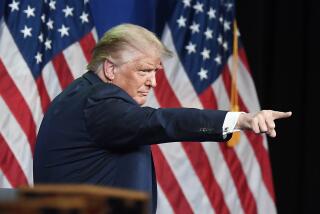Here’s a 6-Point Plan for Rebuilding the Fundamentals of Our Economy
- Share via
The policy-makers who run our economy have finally confessed to an open secret: The U.S. economy is in deep, deep trouble.
“People are hurting,” President Bush recently admitted. “The economy is struggling,” Alan Greenspan, the chairman of the Federal Reserve Board, conceded the following day. And, reflecting its obvious desperation about both the economy and its potential impact on next year’s election, the Fed recently reduced the federal discount rate by a full percentage point, an unexpectedly sudden and sharp cut designed to bolster the flagging “recovery.”
These policy concessions may at first blush seem embarrassing for the Administration. But it would be premature for the Democrats to gloat. For this sudden turnaround reinforces a substantial political risk facing the Democratic Congress and the party’s six announced presidential candidates as we head into 1992.
So far, the Democrats have concentrated almost exclusively on the short-term cyclical weakness of the economy, trying to make political hay out of people’s suffering and highlighting the passivity of the White House on domestic and economic policy. But suppose that lower interest rates help at least marginally to lift the economy out of its recessionary quicksand by the beginning of next summer, creating the impression that conditions are “improving.” Where will that leave the Democrats? They will be high and dry--if they continue to focus on the short term, anyway.
The underlying problems in the economy were clear even before the recession hit. That means that the real need in policy debate is a focus on what can be done to address the fundamentals. Judging from the first months of the political season, the Democrats have had virtually nothing to say on this matter.
What are those underlying problems?
The U.S. economy has been stagnating for nearly 20 years. This stagnation results fundamentally from the top-down structure of economic power and behavior in the United States--from the huge corporate bureaucracies, the maltreatment of workers, the low-wage/low-productivity dead end in which we’re stalled, and the reliance on investment decisions by short-sighted corporate decision makers. These problems have been compounded, not reduced, by the trickle-down policies of the 1980s.
Instead of debating about marginal tax cuts, the Democrats need to start talking about rebuilding the U.S. economy from the bottom up, not from the top down. We need to invest in our human and physical resources, not neglect them. And we need to make much more effective use of those resources, not squander them.
How do we begin? I would suggest six main planks for an economic program designed to begin addressing our fundamental economic problems:
- The government needs to begin investing heavily in our physical and human infrastructure. We need to reverse the trends of the past 15 years and begin to renew our transportation system, utilities and schools. And we need to invest heavily in programs that will improve the skill base of those adults already out of school who have been left twisting in the winds of economic change.
- We should pay for these investments primarily through reduced military spending and higher tax rates on the wealthy. And now that real interest rates have finally begun to fall to manageable levels, we should do everything necessary in order to keep them there--including gaining more democratic control over the otherwise politically independent Federal Reserve Board by making it accountable to either the Congress or the executive branch.
- We need to begin pushing up workers’ wages so that they begin to feel that they have more of a stake in the economy and so that households can begin to escape the vise that has closed tighter and tighter on them since the late 1970s. Two of the best ways in the short run to promote more rapid real wage growth include government priority on job creation, to help create pressure on wages from lower unemployment rates, and continuing increases in the federal minimum wage, to help push wages up from the bottom.
- We need to take clear steps to restore the balance of power in the private sector, helping workers acquire both the influence and the incentives to begin shifting toward a wage-led, worker-led productivity growth regime. We should begin leveling the playing field for workers seeking to form unions through significant and long-awaited reform of our labor laws. And we need to begin constructing the equivalent of a worker’s bill of rights, beginning to afford workers protection against arbitrary dismissal and layoff through policy measures such as advance plant-closing notification.
- We need a household bill of rights to help families protect themselves against disaster and gain greater flexibility in their parenting and working decisions. We could take a giant step forward toward this kind of support through national health insurance and a dramatic extension of publicly sponsored child care.
- We need to free ourselves of exclusive dependence on the capriciousness of private-sector investors. We should establish a national investment bank that would provide targeted investment credit and subsidies to enterprises and corporations, thus building a bottom-up economic revival. Such an investment bank should foster investment, in particular, in firms that reduce managerial waste, encourage worker participation and innovate in the organization of production and administration.
Greenspan warned about the shortsighted lust for a “quick fix” to the economy. It’s the one issue on which I agree with him. Tackling our underlying economic problems doesn’t fit so neatly into sound bites or presidential debates. These six planks won’t provide another chicken in every pot tomorrow. But until we begin to move in these kinds of directions, the recovery of the U.S. economy isn’t going to look much better than the current recession.
More to Read
Get the L.A. Times Politics newsletter
Deeply reported insights into legislation, politics and policy from Sacramento, Washington and beyond. In your inbox twice per week.
You may occasionally receive promotional content from the Los Angeles Times.










